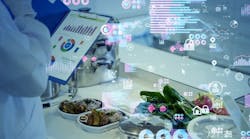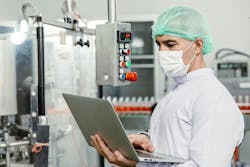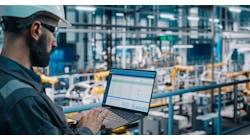Process Control Solutions Innovate through Digitization, AI and Machine Learning
The computer age — and now the digital revolution — has taken human beings to new heights and greater milestones, and food & beverage processing operations have come along for the ride. Digital connectivity, data collection and data analysis have allowed equipment, lines and facilities to talk to each other, making a world of difference in the ability to predict needs and direct resources and efforts appropriately.
“The advancements in food process control have been tremendous, with many vendors coming out with automated process controls for just about every area of food safety,” explains Takashi Nakamura, vice president of food safety for Fresh Del Monte Produce Inc. “However, with the proliferation of advancements also comes challenges.”
Indeed, there are hurdles to overcome in this perpetually changing arena, says Mikael Bengtsson, industry & solution strategy director of the food & beverage team for Infor.
“If you think about the end-to-end process for a processor, there are so many challenges to address and opportunities to capture,” he says. “If you can [set up an optimal process], the processing will be more efficient, improve the yield and increase food safety.”
Jamey Kirsch, sales & account manager for Vicinity Software, says product loss during batch production as well as scheduling and quality control stand as challenges for processors that process software can help resolve in many instances.
“Software that addresses quality control can provide the best possible outcome with extensive quality control measures,” he says. “Quickly creating a certificate of analysis document, reviewing test results over a period of time, integrating quality control tests and procedures, for example, are all necessary since companies up and down the supply chain request this information.”
Processors also battle the speed at which technology and equipment continues to improve, says Andrew Lorenz, founder and CEO of We R Food Safety! “Process control is constantly changing. Software — to include controllers and remote monitoring — has made many advancements, allowing processors to monitor their systems in real time and adjust accordingly.”
According to Nakamura, when selecting automated process control solutions, processors must consider the options available to them in several terms: the operational fit of the solution to their processes; cost of the solutions, including ongoing maintenance and training; the education and training required to maintain proper use of the system, rather than following a “set it and forget it” mentality; and the background of the solution providers themselves to the type of facility the software will serve.
“Software innovation has allowed us to continue our journey for complete digitization, as well as digitalization of food safety. Digitization refers to transferring analog (paper) documents to digital documents, and having a platform that actively houses electronic documents.
“There are many solution providers that will house these documents,” Nakamura says, “but the one challenge is having an ‘active’ management solution that provides insights into potential areas of issues.”
Data, digitization and next steps
As Kirsch tells it, processors have so much data readily available today — way more than many of them ever knew they’d have or how to handle it — the question is how to make sense of it all.
“It’s important to realize that the tools are out there, and they’re not as scary as people might think; you don’t have to invest a huge amount of time or effort to be able to look at data,” he says. “If you’re not taking advantage of all the information available to you as a manufacturer, you are missing out.”
Bengtsson agrees, saying that in order for a processor to optimize, they need to know the as-is state, when they are doing well and when not, and what levers can make the largest impact. Data provides the foundation to answer those questions.
“The challenge becomes how to decipher all the data and make it actionable; modern cloud solutions and innovative technologies have provided the tools to do that,” he says. “I believe the future winners within processing will be the ones who are embracing this.”
Lorenz sees the data revolution still in its adolescence when it comes to the food industry in general, but “it’s something that we have to do in order to deal with labor shortages and competition.”
For a large company like Fresh Del Monte, digitization has assisted global operations. “I can see real-time critical process conditions at a facility half a world away on my screen and mobile device,” Nakamura says. “Digitization has also certainly ‘shrunk’ the global food safety ecosystem with this real-time capability.”
He believes digitization has not made already-complex hardware and software more so, but it still requires precision training, maintenance and awareness of the capabilities of the system. He cautions that although technology can enable more multi-tasking, having the right personnel overseeing the system and its operation remains critical.
As technology improves, the next opportunities will evolve from people’s ability to develop new algorithms to determine risk, especially when considering food safety-related software systems.
“The [current] digital platforms are what I consider passive systems, meaning they store data as it is generated. That data, as well as relevant external data (weather, water data, outbreaks, etc.), then needs to be incorporated into an algorithm to determine potential streams of food safety risks,” Nakamura says. “The capability to take potentially millions or more data points and calculate potential ‘hot spots’ before an event is the next evolution of risk assessment.”
One potential evolution that isn’t too far in the future is the incorporation of artificial intelligence (AI) and machine learning (ML) into these process control solutions. Bengtsson calls it “very exciting times right now,” given the paradigm shift that AI and ML have begun to usher into the food & beverage industry by “solving for challenges that were not even possible to address previously.”
Lorenz sees similar results, with AI “already showing benefits in helping predict potential issues and developing fixes or changes to address issues in our production environment.”
Kirsch says AI and ML hold a lot of promise for food & beverage operators, offering the potential to match product formulas with inventory quantities to determine the batch size, or the ability to provide the most efficient parameters for making a product based on historical machine settings, processing times or temperatures.
“Additionally, with machine learning and historical data, maintenance and clean-out activities can be better scheduled to align with the production requirements,” Kirsch adds. “AI/machine learning/Internet of Things technologies and software can lead to improved operational efficiency and cost savings.”
Although AI has evolved quickly, it still has development ahead of it before flooding into process control solutions and driving changes. Currently, Nakamura says, AI works when asked the right question, but it hasn’t evolved to know what to do with data unprompted. The next leap will be systems that aggregate master data, calculate risks and communicate those risks to the user.
“Today’s AI capabilities are impressive, and linking these capabilities to process control and other relevant data to calculate risks with more data points will be the next generation of food safety,” he says.



